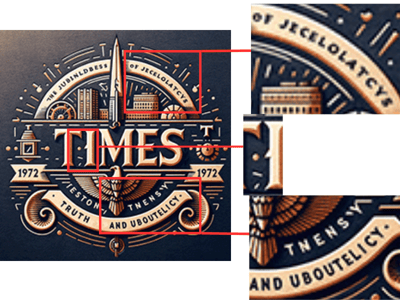By: arron williams
christian haag
iryna hnatiuk
April 12 2024
A web of disinformation: Fake news outlets spreading Kremlin propaganda

Source: Reuters/alamy/mikolajn
Several apparently local U.S. news websites have cropped up in recent months: The Boston Times, The Chicago Crier, The Miami Chronicle, and The San Francisco Chronicle (which shares its name with a legitimate, real local outlet). But why did the Russian Embassy in South Africa recently post an approving screenshot of a Boston Times article, if this was a U.S. outlet? Closer inspection reveals that none of these are real U.S. news outlets at all, and they are, in fact, all likely to be part of a Russian propaganda network.
David Puente, from the Italian fact-checking outlet Open, pointed out that The Boston Times was a fake news outlet, that it copies AI-fabricated evidence, and that the cover image of the article in question was from a 2015 music video.
The New York Times previously connected the Miami Chronicle to other false outlets such as DC Weekly, The New York News Daily, and the Chicago Chronicle, pointing to Russia as the culprit. DC Weekly refuted the claims, stating they were owned by an American citizen, with an identical publication appearing in the Miami Chronicle. Researchers at Clemson University found that the American citizen in question is John Mark Dougan, a former Florida police officer who fled to Russia in 2016.
We found several similarities between the websites. They publish identical or similar articles with the same images, primarily focused on Ukraine, Gaza, U.S. foreign policy, and U.S. news.
Screenshots of The Boston Times, San Francisco Chronicle, Miami Chronicle, and Chicago Crier taken at 13.00 CET on April 10, 2024, showing similarities. (Screenshots/Edited by Logically Facts)
The wider network
The websites have been registered recently. The Boston Times was created on January 18, 2024, but it claims to have been established in 1972. The Miami Chronicle was created on February 26, 2024, but claims to have been active since 1937, and The Chicago Crier and San Francisco Chronicle on March 17, 2024. The San Francisco Chronicle also claims to have been founded in 1999.
The websites include several irregularities. Some of the Miami Chronicle's pages include the dummy "Lorem Ipsum" text as a placeholder. The Boston Times claims to have won the Pulitzer Prize, but Pulitzer has no record of the outlet receiving the award. The Chicago Crier has no information about itself at all. Similarly, the San Francisco Chronicle offers no contact information or other "about" details.
The articles also bear journalist bylines, but these are anonymous: they have no biographies or profile pictures and do not appear to have any other articles online. The only exception is the Chicago Crier, but this only includes the journalists' joining date.
An analysis of images on the Boston Times website also reveals that they have Russian-language file names, which correspond to titles of articles on the Russian news site "Gazeta.ru."
The four websites share a common server. Open also discovered that The Boston Times and San Francisco Chronicle were linked to the same server with a Russian IP address. Antibot4Navalny, a group of researchers that monitors inauthentic Russian language accounts on X, showed how the domains of the websites were connected to John Mark Dougan thanks to Alex Liberty's findings that they had the same domain tracker, connected Cloudflare name servers, and connections to a non-existent "highly acclaimed journalist."
Images posted on the fake news websites traced back to the Russian news site Gazeta.ru. (Source: Screenshots/Composite by Logically Facts)
Antibot4Navalny told Logically Facts, "from our perspective and experience, we are seeing that multiple technical/organizational components of Kremlin's disinfo machine are tightly intertwined in every major episode/narrative promoted."
This all starts with a seeded article by, for example, DC Weekly, which pro-Kremlin outlets pick up. The story then appears in Telegram channels loyal to the Kremlin before being funneled to Russian media such as Sputnik or Pravda and finally ending up on prime-time TV.
Antibot4Navalny also suggested that, based on what we already know, "our best guess for today is that John Mark Dougan (the DC Weekly owner) will soon launch a 'burner' ‘news site' for every new substantial disinfo episode it is about to seed. Each one will be exposed in a matter of a week or two, and effectively 'dies' after that – but that's enough for the story to go viral and 'useful idiots' in Russia AND/or all over the world to believe it widely enough to evaluate yet another disinfo episode as pretty successful."
Seeding and planting false articles
A key theme among the websites is the planting of false stories among actual news. The Boston Times has falsely claimed that Ukraine is working on a "forced fertilization" program. Both the Boston Times and San Fransisco Chronicle published the false story that Zelenskyy smuggled a 300-kilo batch of cocaine during Argentinian President Milei's inauguration.
Following this claim, Russian media quickly began running stories of Zelenskyy transporting a 300-kilo batch of cocaine. Most of the stories referred to The Boston Times as a source, and it also spread across Telegram.
Reports of Zelenskyy's supposed cocaine addiction started appearing online in 2019 when he ran for president, and the narrative became more prominent following the Russian invasion in 2022. Supposed video recordings with evidence of the Ukrainian leader's drug addiction, art installations, and even appeals from Western stars calling for him to quit circulated in social media. All this so-called evidence made up elements of one big fake puzzle.
The Miami Chronicle also claimed that Leonid Volkov, a close aide to the late Russian opposition leader Alexei Navalny, was involved in extensive human trafficking of Ukrainian women. However, the article relied on an investigation by French pro-Kremlin journalist Adrian Boke.
AI-generated logos
The websites show clear signs of AI-generated images, further suggesting that they are fake.


The logos of the Boston Times, San Francisco Chronicle, and Miami Chronicle. The Chicago Crier's logo is just text written in a basic font. The logo for The Boston Times, with elements indicating AI-image generation highlighted. (Source: Screenshot/Markup by Logically Facts)
The Boston Times contains multiple errors and features consistent with AI image generation. The same dots and lines scattered around the image also appear between the "T" and "I" of the word "TIMES." The logo's text reveals nonsense words, and random character strings, like "jecelolatacys" and "uboutelicy," also appear.
Disinformation: Nothing new
The Soviets utilized disinformation, and their intelligence and domestic security agency, the KGB, to spread false information during the Cold War.
Professor Kenneth Osgood, who teaches history at the Colorado School of Mines, told Logically Facts, "Disinformation implies deliberate distribution of contrived information. 'Fake news' as we call it. This was definitely a long-standing tactic of Russian/Soviet intelligence and information operations."
These tactics were extended to the press through KGB attempts to influence the media and attempts to spread fake stories. For example, in the 1980s, rumors that AIDs was created by U.S. biological weapon experiments were spread by pro-Soviet sources. The claim appeared in the Indian pro-Soviet newspaper The Patriot and the Soviet newspaper Literaturnaya Gazeta. The story was then later picked up by a non-Soviet British tabloid and circulated in international media. However, a 1985 cable from the former East German Police outlined how the Soviet Union was promoting the idea AIDS was a U.S. biological weapon, and in 1992 former Soviet intelligence chief and later Russian president Yevgeny Primakov told Russian press the KGB orchestrated the AIDS rumors.
Professor Osgood further explained that the Soviets didn't quite make fake newspapers and instead "a more common form of influence was the old fashioned way: money. The KGB (and CIA) dolled out financial support to news outlets, prominent persons, publishing houses, and other forms of media all over the world. Often such funding was routed through front groups – organizations that appeared to be private, but were secretly controlled or subsidized by intelligence services."
Commenting on the websites and their disinformation tactics, David Puente from Open told Logically Facts that today's modern techniques are more sophisticated as they create fake websites with fake newspaper names – but they use sources. However, the sources are mostly Russian websites, Telegram channels, or unknown individuals interviewed by RT.
In the case of these websites, Puente added, "People read the name and think, 'Wow! A newspaper says it!' With cell phones, the graphics are minimal, and these sites appear credible and authoritative. This 'trick' worked in 2016 and works today in 2024; the network of Russian sites like The Boston Times does the same."


